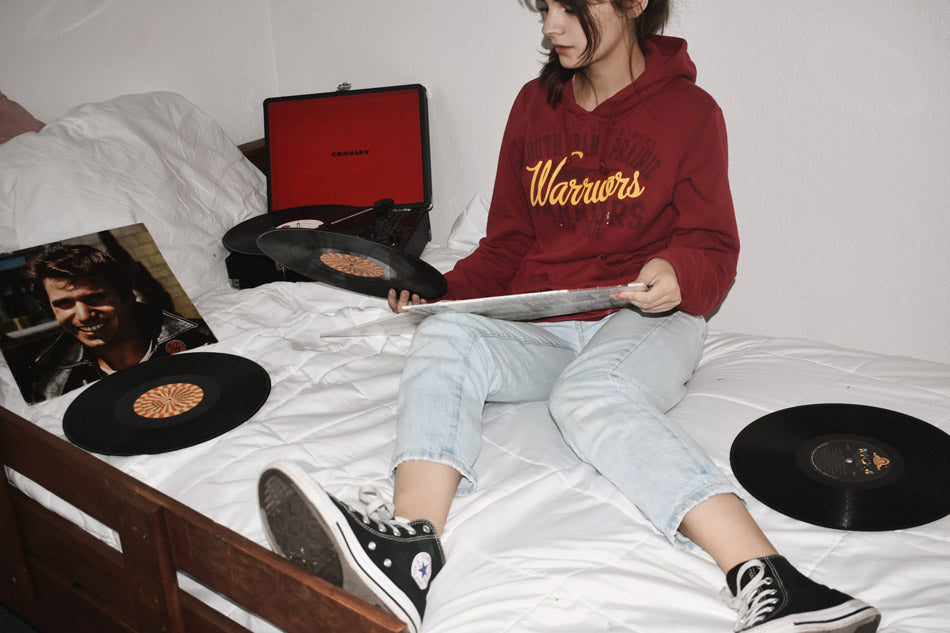
Organizing Vinyl Records | How to Make It Fun and Meaningful
Share
If you’re still just stacking your vinyl records in a corner or sorting them in the order in which you purchased them, it’s time to get your house in order. Organizing vinyl records shouldn’t feel like a chore or an inconvenience. It’s something to take pride in. There are numerous ways to go about it, some of which are quite satisfying once you get started.
1. Go the Alphabetical Route
Let’s get the obvious method out of the way first. The most basic way to organize your vinyl records is to lay them out on the floor and start alphabetizing them. You might start by tossing one of your favorite records on the turntable so you have something fun to listen to while you work—perhaps a classic Coltrane or the latest Ariana Grande (we have no idea what you’re into, so find your favorite motivational jams).
The obvious benefit to alphabetizing is that you’ll be able to easily find any record at a moment’s notice. You want to listen to Drake? Just skim your way over to the Ds. Looking to revisit Sgt. Pepper’s Lonely Hearts Club Band? You’ll find The Beatles near the top shelf.
This approach to organizing vinyl records is practical, but it’s not for everybody. If you have wildly diverse musical tastes that run the gamut from punk rock to Broadway and EDM, a different organizational method might be in order. Which leads us to our next tip...
2. Organize by Category
For the avid collector, or for the collector with broad tastes, it’s usually best to organize by category. This is where the process can really become fun and creative.
Notice that we said category and not genre. Anyone can sort by genre: pop, country, R&B… But your music is personal to you, and you might have your own ideas for how to categorize your vinyl. For example, you might start with basic genres like “‘80s Pop” and “Electronic,” but then you might add categories that are significant to you personally like “My Summer ‘99 Soundtrack,” “Music That Gets Me Pumped,” and “Nostalgia.” You can create a category for whatever has meaning for you and whatever inspires you most.
3. Clean as You Organize
When organizing vinyl, you have a golden opportunity to give those records a quick cleaning and ensure that they continue playing to perfection. There’s something satisfying and therapeutic about dusting off and cleaning each record as you make your way through the collection. It gives you the chance to pause and reflect on each record and how you came to acquire it, and it affords you a sense of accomplishment.
The Big Fudge Vinyl Cleaning Kit makes this process simple. It takes care of dirt, dust, fingerprints, and other blemishes. Just spray the record with the alcohol-free cleaning solution and use the velvet brush to wipe down the surface. It’s easy, quick, and scratch-free. Best of all, your records will sound like new.
4. Make a Statement With Your Display
Once you decide how you want to go about organizing your vinyl records, the next step is to decide how you want to display them. Record frames are a fun choice for some of your favorites; they make for an easy, stylish decor option. Choose records that have aesthetic appeal as well as personal significance, and organize them neatly along the wall.
Shelves and shelf racks are also classic choices if you have the space available. Some crafty DIYers have even built their own displays modeled after the vinyl shelves in record stores. But again, this will require some additional space in the home.
If you want to make a statement with your vinyl but you have thousands of records taking up space, sort through your collection and pick out your favorites—the ones that you’re most likely to revisit on a regular basis. You can then keep your most cherished records on display without overtaking an entire room. For the remaining records, you can organize and sort them into vinyl record storage boxes.
5. Log Your Collection

Creating an official log or summary of each record is fun for a number of reasons. It allows you to officially document your collection, it shows you how far you’ve come as a collector, it reveals any gaps or missing essentials, and it makes it easy to find just the right record at a moment’s notice.
The easiest way to log your collection is to use a website like Discogs. However, you can also create your own spreadsheet when organizing your vinyl records. You’ll want to include the following information:
- Artist
- Album Title
- Year
- Genre
- Personal Notes
So if you decide one day that you feel like listening to oldies from the 1960s, you can sort your spreadsheet by year and scan all of the records from the ‘60s. If you feel like listening to hip-hop, you can filter by the hip-hop genre and see all of your best choices at a glance. As you start logging your collection, you’ll be motivated to purchase even more—fleshing out those genres and artists that aren’t as well fleshed-out as you had hoped.
6. Swap Out the Records You Don’t Want
When organizing vinyl, you’re bound to find records you neither want nor need. Maybe you discover that you have an extra copy of Guns N’ Roses’ Appetite for Destruction, or perhaps you regret buying that Frank Sinatra album where he attempts to cover rock songs.
Put those unwanted records aside. When you finish organizing, you may be able to trade them in at your favorite used record store and invest in some new (or new-to-you) vinyl that’s missing from your collection.
No matter how you go about organizing your vinyl records, make it a fun and personal experience. Each record says something about you or has significance to some aspect of your life. Take pride in your collection, and treat it well.


